This post contains affiliate links. As an Amazon Associate and member of RewardStyle, I earn from qualifying purchases. Please visit our privacy policy for details.
Ever found yourself overwhelmed with piles of tiny baby clothes, unsure of how to keep them organized? Does your baby’s nursery look more like a tiny clothes tornado, rather than a peaceful haven?
Let’s discover efficient and stylish ways to organize baby clothes. I’ll cover space-saving tips, sorting techniques, and creative storage solutions to keep your little one’s wardrobe neat and accessible. Perfect for parents seeking practical, clutter-free nursery ideas! In today’s post I’ll dive into:
- Understanding the importance of organizing baby clothes
- Essential items required for baby clothes organization
- Best practices to organize baby clothes in the nursery
- Tips on maintaining the organization system

Importance of Organizing Baby Clothes
Baby clothes might be small, but the chaos they can create is not. The importance of organizing your baby’s clothes cannot be overemphasized.
It Simplifies Your Life
- Regular organization of your nursery will make your life surprisingly simpler.
- No more hunting for the right size or type of clothing.
It Saves Time
- Having baby clothes systematically arranged saves a lot of time.
- You won’t have to rummage through a drawer full of clothes to find a single onesie your baby needs right now.
It Keeps Baby Clothes in Good Shape
- Proper organization not only keeps the clothes easily accessible, but it also elongates their life.
- Prevents them from getting stretched out, wrinkled, or damaged.
It Lowers Stress Levels
- Knowing exactly where each item of clothing is, can substantially lower stress levels.
- A clean and tidy space can also be a contributing factor in better mental health.
Understanding the importance is the first step. In the coming sections, we will discuss the essential items for organization and the best means to achieve a well-organized nursery.
Essential Items Required for Baby Clothes Organization
Organizing baby clothes effectively requires some fundamental items. Various options are available based on both your needs and personal style preferences. Below, we delve into some of the important things you require for this organizational process.
Baby-Sized Hangers
Properly sized hangers are crucial in baby clothes organization. They come in different styles, materials, and sizes that can match your baby’s clothes sizes and your preference.
Natural Organic Rattan Kid’s Clothing Hangers
- Rattan hangers are very durable and are free from the chemicals and toxins often found in plastics, such as BPA, phthalates, and other harmful additives. These chemicals can leach out over time and potentially harm sensitive baby skin. Natural rattan, on the other hand, is safer for direct contact with baby clothes.
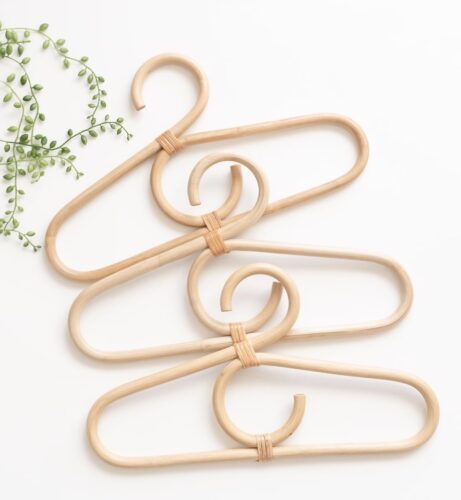
Velvet Hangers
- These hangers keep clothes from slipping off and are slim, bringing an element of compactness to your baby’s closet.
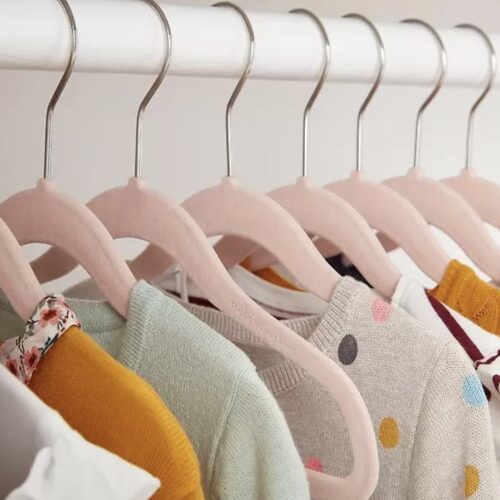
Clothing Dividers
Dividers are indispensable during the organization process. They help section off different types of clothes or organize by size, making it easier for you to locate what you need quickly.
Wooden Closet Dividers
- These dividers can be used to separate clothes of different sizes, types, and seasons.
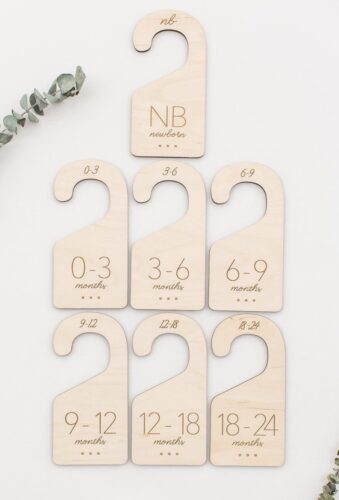
Drawer Dividers
- These are suitable for segregating small items such as socks, hats, and bibs into dedicated sections.
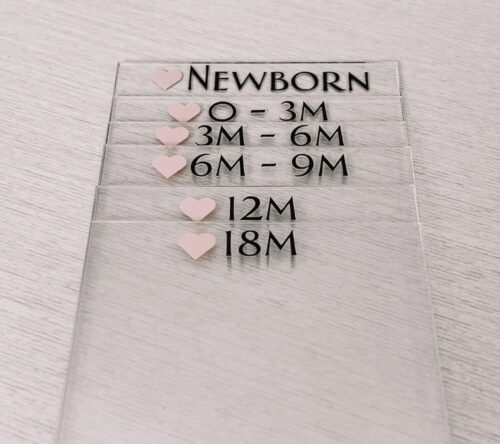
Baskets and Bins
Baskets and bins offer additional storage space and are great for organizing smaller clothes pieces and accessories. They can be stored in the closet or placed on shelves for easy access.
Foldable Storage Bins (I like the organic/natural material ones best)
- These can be used to store bulkier clothes such as sweaters and blankets.
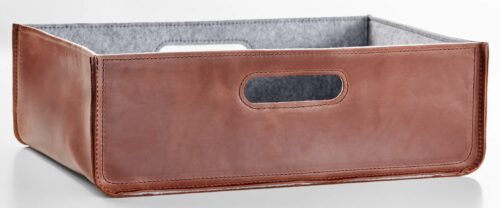
Baskets & Bins
- These are useful for storing smaller and frequently used items within easy reach.
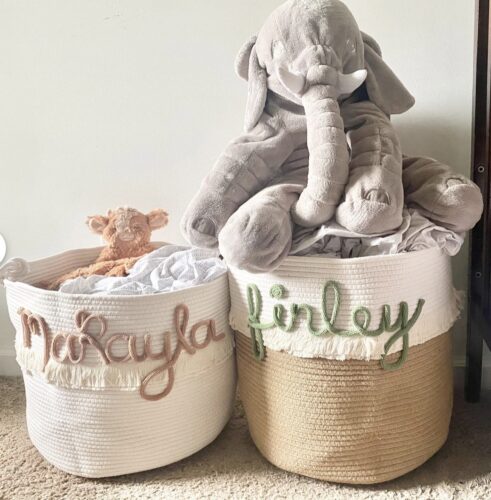
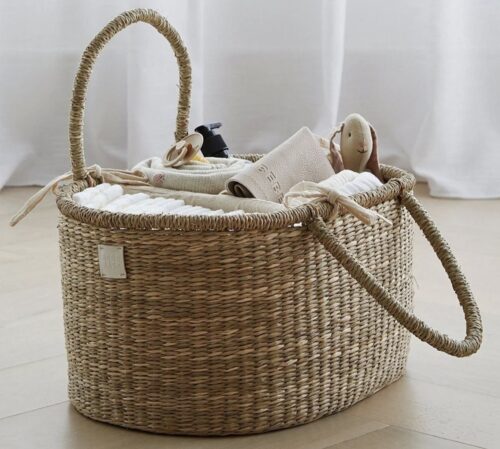
How to Organize Baby Clothes in the Nursery
In this section, we unpack ideal strategies for organizing baby clothes. Each of these methods is designed to simplify your life and make the nursery a more functional space. You can blend these approaches based on your particular space and requirements.
By Type of Clothing
Organizing by type of clothing simplifies searching for specific clothing items. This could involve sectioning the clothes into categories like:
- Onesies: You can dedicate a specific drawer or cubby for onesies, making it easy to pull one out when needed.
- Socks and Accessories: Smaller items like socks, mittens, and hats can go in a divider or shallow basket.
- Seasonal Clothes: For instance, you can group all the winter clothes or summer clothes together.
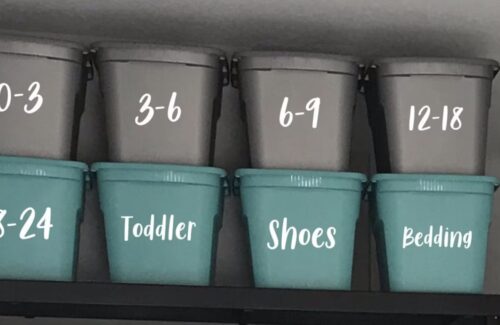
By Size
Baby clothes come in a variety of sizes, and keeping their wardrobe organized by size can be a practical approach.
- Sequentially: You can arrange clothes from smallest to largest so you can easily find a suitably-sized outfit for your baby.
- Dividers: Use closet dividers to separate clothing of different sizes.
Storage Furniture Options
Space-saving storage furniture can be used to stash clothes, making the nursery tidy and clutter-free.
- Wardrobe or Closet: Cut down on clutter by ensuring every item has a space in the closet.
- Drawer Chests: Make use of drawer chests for items like vests and undergarments.
- Shelves: Shelves are ideal for storing baskets or bins filled with clothes that are not frequently in use.
- This custom storage kit on Etsy is really cute: Simple Luxe Baby Closet Organization Kit Gift Set
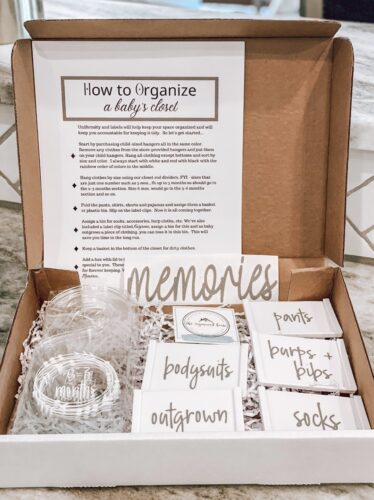
Frequent Usage
This involves organizing based on how often certain clothes are worn.
- Easy Access For Daily Use: Regularly worn clothes should be placed at arm’s reach. These may include pajamas, onesies, and everyday outfits.
- Occasional Wears at the Back or Bottom: Outfits for special occasions can be kept at the back of the wardrobe or the bottom drawer.
Remember, it’s crucial to have a system that adapts to changes as your baby grows. Keep the setup flexible, so it remains functional. With these organization methods, you can keep your child’s nursery clean, well-ordered, and make dressing your baby a significantly smoother process.
Maintaining the Organization System
Organizing the nursery isn’t a one-time task – maintaining the organization system is equally important. The right maintenance strategy will ensure that your baby’s clothes remain easily accessible and organized. Here are a limited number of techniques to conserve the system’s effectiveness over time.
Regular Checks and Adjustments
Babies grow rapidly, and so do their clothing needs. Regular checks and adjustments are necessary to keep up with their evolving wardrobe.
- Upgrade Clothing Categories: As the baby grows, adjust the sections as necessary. For instance, if the baby outgrows certain clothes, move them out of the main storage areas.
- Seasonal Sort-outs: With the change of seasons, rotate clothes as necessary. Store away off-season clothes until required again.
Consistent Habits
Developing a routine can greatly simplify maintenance. An organized nursery should not just be an objective, but a habit.
- Daily Tidying: Make it a habit to return items to their rightful places immediately after use.
- Laundry Routine: After laundry, immediately fold and place the clean clothes in their designated spaces. Don’t let clean garments pile up.
Teach and Involve Older Siblings
Involving older siblings in maintaining the organization can offer valuable assistance and impart critical organizational skills.
- Show Them How: Teach older siblings where everything goes, reinforcing the habit of placing items back to their rightful places.
Utilize Storage Solutions
Having appropriate storage solutions will make the continuous task of maintaining the system much easier.
- Expandable Storage: As your baby’s wardrobe grows, having expandable storage solutions will make it easier to accommodate new clothes.
- Use Labels: Update labels to match with new organization sections.
Maintaining your baby’s wardrobe organization is a continuous process, yet the benefits are immense. An orderly wardrobe not only looks pleasing but also saves time during busy schedules, making life much easier for you and your little one.
Conclusion
In this insightful article, we’ve provided comprehensive strategies and tips on the best ways to organize baby clothes in a nursery.
- The significance of having an organized system for baby clothes in order to make parenting easier and more efficient
- Essential items required for baby clothes organization such as hangers, dividers, and baskets
- Top-notch methods to organize baby clothes in the nursery, and how to get the most out of these techniques
- Importance of maintaining the organization system with regular checks and adjustments for continued effectiveness
Incorporating these practical tips into your routine not only simplifies parenting but also promotes a clutter-free environment conducive for your baby’s growth. Now that you’re equipped with this information, take the next step by purchasing the right organization tools to enhance your nursery’s functionality and aesthetics. Start implementing these strategies today for a smoother, stress-free parenting journey.
Frequently Asked Questions
What are the essential items required for baby clothes organization?
Essential items needed for organizing baby clothes include dividers, hanging labels, hangers, storage bins and baskets. These tools help categorize clothes according to size, type, and usage, making it easy to identify and locate items quickly.
How do I maintain the system once I have organized the clothes?
Maintaining a baby clothes organization system is crucial. Ensure that you put items back in their designated places after use. Regular checks and slight adjustments will also be necessary as your baby grows and the type of clothing changes.
Why is it important to organize baby clothes?
Having a system for organizing baby clothes can save you a lot of time and reduce stress. It eliminates the challenge of finding a specific item when needed and keeps the nursery tidy, making it a safe and comfortable environment for your baby.
What is the best way to organize baby clothes in a nursery?
The best organization method is one that suits your needs and space availability. However, common effective strategies include categorizing clothes by size using dividers or labels, hanging clothes that wrinkle easily, and storing off-season or less used items in bins or baskets.